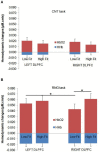Improved cerebral oxygenation response and executive performance as a function of cardiorespiratory fitness in older women: a fNIRS study
- PMID: 25339900
- PMCID: PMC4189417
- DOI: 10.3389/fnagi.2014.00272
Improved cerebral oxygenation response and executive performance as a function of cardiorespiratory fitness in older women: a fNIRS study
Abstract
Cardiorespiratory fitness has been shown to protect and enhance cognitive and brain functions, but little is known about the cortical mechanisms that underlie these changes in older adults. In this study, functional near infrared spectroscopy (fNIRS) was used to investigate variations in oxyhemoglobin [HbO2] and in deoxyhemoglobin [HHb] in the dorsolateral prefrontal cortex (DLPFC) during the performance of an executive control task in older women with different levels of cardiorespiratory fitness (VO2max). Thirty-four women aged 60-77 years were classified as high-fit and low-fit based on VO2max measures. They all performed a control counting (CNT) task and the Random Number Generation (RNG) task at two different paces (1 number/1 s and 1 number/1.5 s), allowing to manipulate task difficulty, while hemodynamic responses in the bilateral DLPFCs were recorded using continuous-wave NIRS. The behavioral data revealed that the high-fit women showed significantly better performance on the RNG tasks compared with the low-fit women. The high-fit women showed significant increases in [HbO2] responses in both left and right DLPFCs during the RNG task, while the low-fit women showed significantly less activation in the right DLPFC compared with the right DLPFC of the high-fit women and compared with their own left DLPFC. At the level of the whole sample, increases in the [HbO2] responses in the right DLPFC were found to mediate in part the relationship between VO2max level and executive performance during the RNG task at 1.5 s but not at 1 s. These results provide support for the cardiorespiratory fitness hypothesis and suggest that higher levels of aerobic fitness in older women are related to increased cerebral oxygen supply to the DLPFC, sustaining better cognitive performance.
Keywords: aerobic fitness; aging; executive functions; functional near-infrared spectroscopy (fNIRS); prefrontal cortex.
Figures





References
-
- Albinet C., Tomporowski P. D., Beasman K. (2006). Aging and concurrent task performance: cognitive demand and motor control. Educ. Gerontol. 32, 689–706 10.1080/03601270600835421 - DOI
LinkOut - more resources
Full Text Sources
Other Literature Sources

